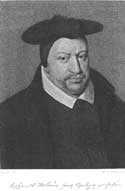Molanus

Jan Vermeulen or Jan van der Meulen, (or Johannes, Jean, Ioanne) also known as Molanus (the Latin version, in French "Molano") (1533–1585) was an influential Counter Reformation Flemish Catholic theologian of Louvain University, where he was Professor of Theology, and Rector from 1578. From 1561 to 1563 he was headmaster at the Latin School in Duisburg, today's Landfermann-Gymnasium. Born at Lille (then under the Habsburgs), he was a priest and canon of St. Peter's church in Louvain, where he died.
Among many other subjects he wrote on the proper content of religious images, taking a very severe line in his De Picturis et Imaginibus Sacris, pro vero earum usu contra abusus ("Treatise on Sacred Images") of 1570. Five further, enlarged, editions of this appeared between 1570 and 1771,[2] and a modern French translation has been published, most recently in 1996.[3] He was lead editor of an edition of the works of Saint Augustine (Antwerp, Plantin Press, 1566–1577), and wrote a history of Louvain.[2]
He is not to be confused with Gerhard Wolter Molanus (van Meulen), 1633–1722, an influential German Lutheran theologian.[4]
Molanus and art
Molanus is today mainly remembered by art historians for being one of the first authorities to turn the short and inexplicit decrees of the Council of Trent (1563) on sacred images into minutely detailed instructions for artists, which were then widely enforced in Catholic countries. His views on the older, originally Byzantine, traditional depiction of the Nativity are typical:
The Virgin is shown pale with pains, the midwives prepare a small (narcotic) drought for the childbirth. Why this? Is it because the Virgin Mary would have held back from any pain of childbirth, when in fact she brought forth her divine son without pain? And what pertains to the midwives who are mentioned in the apocryphal Book of the Infancy? Jerome says: There was no midwife! No obtrusiveness of women intervened! She, the Virgin, was both mother and midwife! I saw in not a few places the picture of the blessed Virgin lying on a bed, depicting childbirth, and she was suffering pains from this birth, but that is not true. How stupid! Those artists ought to be laughed at who paint Mary in the very act of childbirth pains, accompanied with pain, midwife, bed, little knives (to cut the umbilical cord), with hot compresses, and many other appurtenances. . . . Rather, those pictures should be promoted which show the birth of Christ in which the Blessed Virgin Mary with arms folded and on bended knee before her little son, as though he was just now brought forth into the light.[5]
He objected on similar grounds to the Death of the Virgin, her swooning at the foot of the Cross, and her being shown supplicating Christ for mankind in Last Judgement scenes. She would, he said, in fact be sitting alongside Christ in stern judgement:
Many painters show Mary and John the Baptist kneeling beside Our lord at the Last Judgment...But we may not think that at that day the Virgin Mary will kneel for us before the Judge, baring her breast to intercede for sinners. Nor may we think that John the Baptist will fall upon his knees to beg mercy for mankind in the way the painters show. Rather, the blessed Virgin and St. John shall sit beside the supreme Judge as assessors. The mercy which is extended now will have no place then. There will only be strict justice at that day.[6]
Also condemned were Saint Christopher as a giant carrying Christ (and as the protector of travellers), Saint George and the Dragon, the Holy Kinship, the unicorn hunt in the Hortus Conclusus and many other depictions not verifiable from reliable sources – the Golden Legend was, he said, in fact of "lead".[7]
Nudity, even of the infant Jesus, was to be avoided as much as possible, and drapes must cover the genitals where it could not be.[8] Whilst condemning older depictions without a scriptural basis, he was not hesitant in creating new ones based on his own interpretation.[9] Saint Joseph should not be shown as the old, semi-comical figure of the Middle Ages, but as young, vigorous and firmly in control of the Holy Family. Mary Magdalene should not be shown as an over-dressed prostitute, and generally dress should be simple.[7] He opposed showing the spasimo or Swooning Virgin Mary in scenes of Christ carrying the Cross or the Crucifixion itself.[10]
Notes
- ↑ Delannoy, P. (May 1915). "The Library of the University of Louvain". United Settlement.
- ↑ 2.0 2.1 Freedburg, David. "Johannes Molanus on Provocative paintings". p. 1, note 2. Retrieved 2013-12-13.
- ↑ Edition details
- ↑ German Wikipedia article
- ↑ Mary: Mediterranean Maid and Mother in Art and Literature, Jerome H. Neyrey, University of Notre Dame, Abstract, Biblical Theology Bulletin 20 (1990) 65-75.
- ↑ Online, with example of the depiction condemned De Historia SS. Imaginum et Picturarum, 1594, Book iv. cap. 24. translated in A. Caiger-Smith, English Medieval Wall Paintings [Bibliography Page], p. 35.
- ↑ 7.0 7.1 Mâle, online
- ↑ Blunt 1985, pp. 114, 118.
- ↑ Blunt 1985, p. 127; Mâle
- ↑ Penny 2004, p. 26.
References
- Blunt, Anthony, Artistic Theory in Italy, 1450-1660, chapter VIII, especially pp. 107–128, 1940 (refs to 1985 edn), OUP, ISBN 0-19-881050-4
- Mâle, Émile, l'Art religieux après le Concile de Trente, étude sur l'iconographie de la fin du XVIe, du XVIIe et du XVIIIe siècles en Italie, en France, en Espagne et en Flandre (1932) (also translated) Molanus and the death of Medieval Art, Extract from book
- Penny, Nicholas, National Gallery Catalogues (new series): The Sixteenth Century Italian Paintings, Volume I, 2004, National Gallery Publications Ltd, ISBN 1-85709-908-7